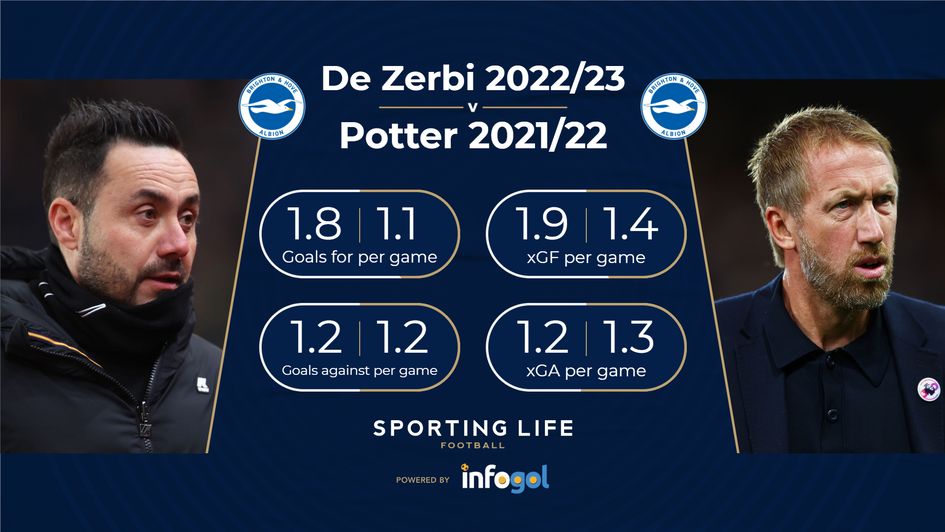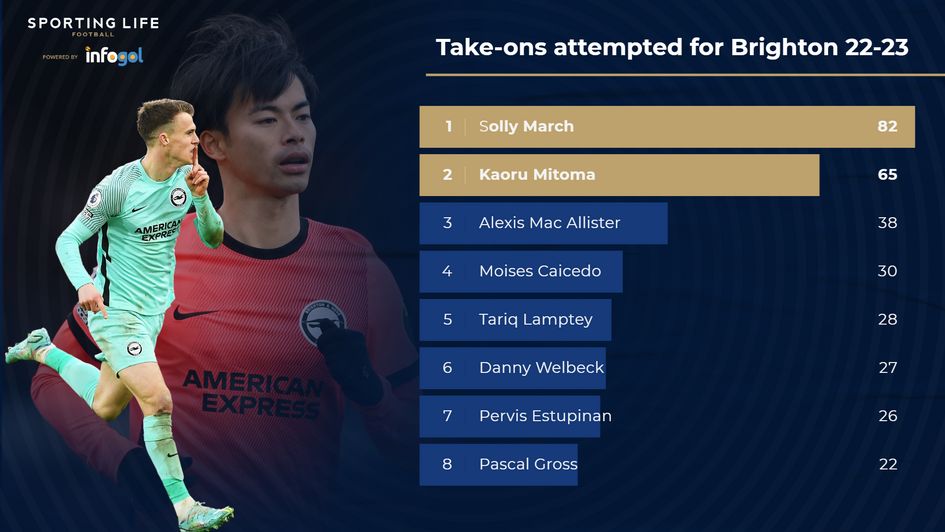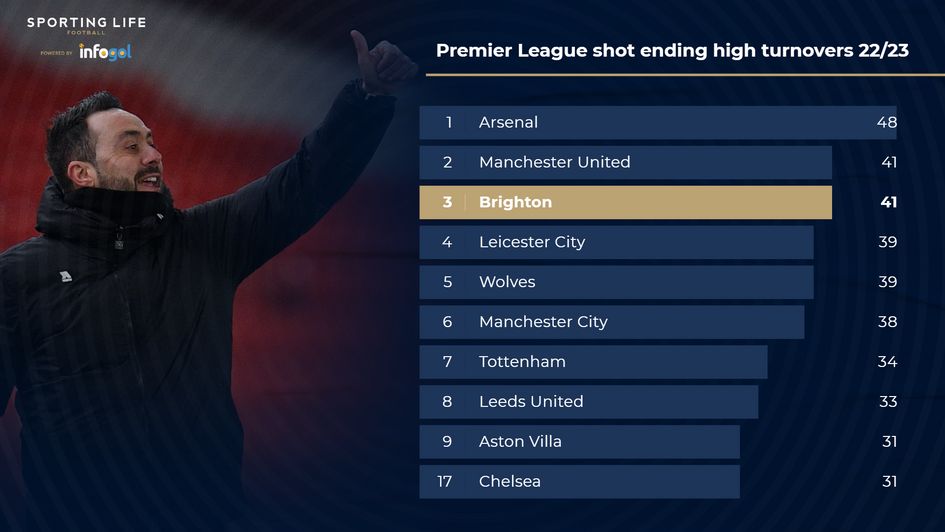“His impact in England will be massive in the future.” When Pep Guardiola makes a prediction about a fellow manager’s tactical legacy it is usually wise to listen, and indeed in the space of just a few months Roberto de Zerbi has emerged as one of the most exciting tacticians the Premier League has seen.
- First published before Brighton 1-0 Palace
If that sounds hyperbolic then consider that Brighton are seven points behind fourth-placed Tottenham with three games in hand despite having lost manager Graham Potter in September; despite having lost three of their best players (Marc Cucurella, Yves Bissouma, and Leandro Trossard); and despite altering their strategy considerably under the new head coach.
Premier League top four finish (odds via Sky Bet)
- Manchester Utd - 1/5
- Newcastle - 1/1
- Liverpool - 2/1
- Tottenham - 2/1
- Brighton - 9/2
Odds correct at 1630 BST (20/03/23)
Similar yet different from Potter
In many ways De Zerbi and Potter are similar, which of course is precisely the point of hiring the former Sassuolo manager: consistency in style brings seamless movement and clear progression no matter how many stars, players or staff, are poached by bigger clubs.
Like his predecessor De Zerbi is all about high pressing and long periods of possession, complete with the automatisms that allow Brighton to move the opponent around with pre-planned movements.
But the similarities are only in those broad brushstrokes. As Jurgen Klopp said: “Before, they played Potter-ball. Now they play De Zerbi-ball.”
De Zerbi’s most unique trait among the possession-centric managers is his desire to lure the opponent forward, baiting them to press higher in order to then spin around the onrushing bodies and charge, vertically, into space.
This is without doubt the new frontier in elite-level tactics and while De Zerbi is by no means the innovator (Aston Villa’s Unai Emery does exactly the same thing) the way he marries this with hogging the ball is unusual.
Combination of Guardiola and Klopp
It is an interesting hybrid of Guardiola’s ideas of territorial domination and Jurgen Klopp’s concept of gegenpressing, in that De Zerbi uses the former to twist the opposition’s idea of the latter: Brighton look to hold the ball for very long periods of time in their own third and the middle third, which eventually forces the other side to enact a pressing trigger – at which point Brighton surge forward.
This explains the unusual visual of Brighton as increasingly possession-oriented - they average 62.5% under De Zerbi, compared with 49.9% under Potter – while also arriving into the final third at greater speed, and with more space, than under the old regime.

It is a brilliant merging of two of modern football’s great ideas that allows a club of Brighton’s status to play like Manchester City and Liverpool simultaneously.
Assisting this change of approach is a formation move from Potter’s 3-4-2-1 to a 4-2-3-1 that, most of the time, looks more like a 4-2-4, with a far greater emphasis on out-and-out attackers being fielded in the side.
Whereas Potter looked to play predominantly through his shape-shifting wing-backs, building meticulously by packing the side with technical midfielders, De Zerbi has flipped the system – with most of Brighton’s play now funnelled through the middle of the pitch.
Having so much possession helps Brighton sit closer to goal but it also means their talented playmakers are on the ball more often in the number ten space, with Alexis MacAllister, Pascal Gross, and Moises Caicedo regularly swirling around the area between the centre circle and penalty box.
This, again, increases Brighton’s creativity and directness, ensuring there are high numbers of talented attackers ready to spring into action once the opposition press allows for those fast breaks to be launched.
It helps, too, to have electric wingers on either side in Kaoru Mitoma and Solly March – another example of De Zerbi putting round pegs in round holes where Potter would endlessly curve towards a more conservative configuration in the final third.

It also explains Brighton’s increased effectiveness when pressing from the front: they have already managed 40 shot-ending high turnovers this season (third most in division) after finishing on 45 (11th most) last year.

Most obviously, the combination of these factors has improved their goals return, with 34 in De Zerbi’s 18 Premier League matches so far, and while Brighton’s xG figures have not improved it is possible that the difference between the two managers is not accurately reflected in those figures.
Potter, perhaps, consistently under-performs against xG (at Brighton and Chelsea) because the slow nature of his attacking moves means there are plenty of opposition bodies in front of the ball when a shot is taken, whereas De Zerbi’s Brighton so often arrive as if in the counter-attack.
De Zerbi-ball not without weaknesses
The approach is not without its weaknesses. Plausibly opponents will soon cotton on to Brighton’s trap and refuse to press, leading to a tedious Mexican standoff that sucks the energy out of De Zerbi’s strategy, although of more immediate concern is the defensive vulnerability that comes from pressing so hard, attacking so vertically, and passing so riskily out from the back. Brighton’s 3-3 draw with Liverpool in De Zerbi’s opener showed the best and the worst of what he has to offer.
In that game, as in many others since, Brighton’s passing got them into trouble, provoking successful pressing that led to easy chances for Klopp’s side. Recent defensive performances have improved but the risk-reward strategy may never bring the stable results required to bridge the gap to fourth.
Not this year, anyway. Providing De Zerbi is not poached this summer Brighton will presumably target a centre-forward and centre-back in the summer to complete the picture and provide their manager with the opportunity to confirm to us that he is one of the game’s most complex and fascinating tacticians – destined for the top of the game.






